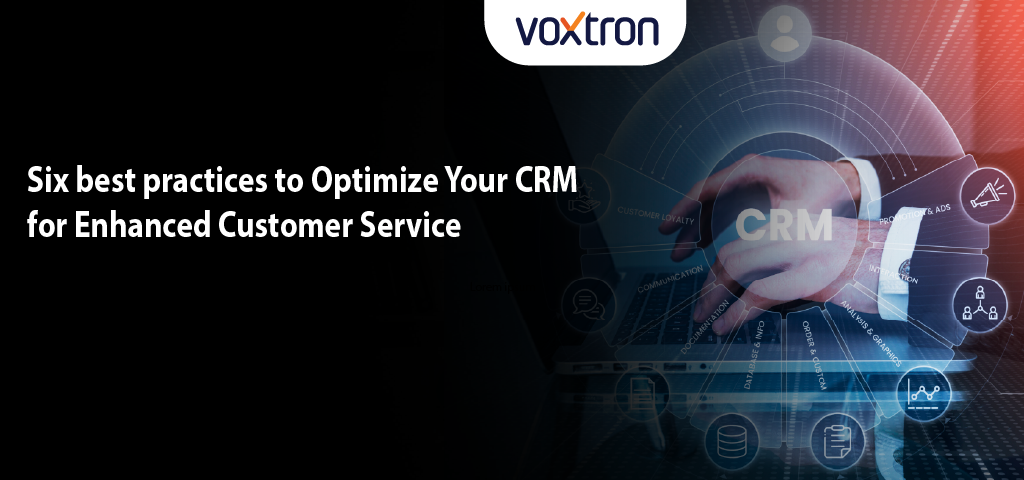
Maximizing ROI with Knowledge AI in Chatbots: A Guide for Modern Enterprises
August 26, 2025
Are You Losing Customers Due to Poor Contact Center Efficiency? Discover How CCaaS Can Help
September 16, 2025Six Best Practices to Optimize Your CRM for Enhanced Customer Service
Most businesses invest in a CRM to improve customer experience. After CRM implementation, teams usually receive initial training, a few workflows are set up, and then the system is expected to run on autopilot.
Thus, once the CRM is up and running, they rarely revisit it. Over time, what was meant to be a powerful business tool becomes underutilized and disconnected from the company’s growth strategy.
That’s why CRM optimization is a strategic necessity. When done right, it can continuously improve customer satisfaction, boost operational efficiency, and positively impact the bottom line.
So how can you optimize your CRM for enhanced customer service? And why is Odoo CRM uniquely positioned to support this transformation?
Let us explore six best practices to not only streamline CRM operations but also deliver a competitive edge, especially when backed by a flexible, fully integrated system like Odoo.
1. Make Customer Data Accessible Across the Organization
One of the biggest limitations in CRM usage is restricting access to only sales or customer service teams. But in reality, customer data is relevant to multiple departments such as marketing, logistics, billing, product development, and even HR.
Why centralized access matters:
- Teams get a single source of truth across the customer journey.
- Your service becomes seamless. This means no more repeated questions or fragmented support.
- Everyone can contribute to and benefit from deeper customer understanding.
For example, while a support agent views a customer’s complaint, they can also access their purchase history, delivery status, and pending invoices without switching systems.
This holistic visibility enables faster, more informed responses and fosters a culture of collaboration across your organization.
With Odoo CRM, integration with other Odoo apps is possible. Thus, all departments share a live, 360-degree view of every customer.
2. Focus on User Adoption and Automate Repetitive Workflows
Poor user adoption may be caused either by a complex interface or the burden of manual data entry limits the efficiency of a new CRM.
Best practices for boosting adoption:
- Involve frontline users in the setup and testing stages so the system reflects real needs.
- Offer ongoing training, not just a one-time session. Microlearning, peer sharing, and periodic refreshers help.
- Assign “CRM Champions” in each team to encourage usage and resolve issues early.
Where automation helps:
Automation further streamlines processes and enhances the efficiency of a CRM. Instead of wasting time entering data, agents and staff can focus on solving customer issues or closing deals.
Odoo CRM allows you to:
- Auto-create leads from emails or web forms.
- Route tickets to the right teams automatically.
- Set task reminders based on customer interactions.
- Trigger personalized marketing messages based on CRM activity.
This not only saves time but also ensures a more consistent and proactive approach to customer engagement.
3. Keep CRM Data Clean, Accurate, and Compliant
Your CRM is only as powerful as the quality of its data. Dirty data like duplicate records, outdated emails, or incorrect phone numbers can create confusion, affect campaign results, and erode trust.
Steps to maintain clean data:
- Set validation rules and dropdown lists to reduce entry errors.
- Create naming conventions for accounts, contacts, and opportunities.
- Use deduplication tools and regularly review inactive or obsolete entries.
- Ensure GDPR or regional compliance with proper data collection, consent logs, and opt-out options.
Odoo CRM supports these practices with tools like field-level access control, real-time deduplication, and audit trails. Plus, because it syncs data across apps (like Sales or Marketing), updates made in one place are instantly reflected across the system, keeping everything accurate and up-to-date.
4. Leverage Mobility and Self-Service to Empower Users and Customers
Modern customers expect round-the-clock customer service. This makes it important for businesses to deliver support outside office hours. Furthermore, mobile service and self-service options are also a common expectation.
Empowering teams with mobile CRM:
- Update leads, tasks, or tickets directly from the mobile app.
- Access past conversations and key customer details while traveling.
- Get real-time alerts for urgent issues or deal movements.
Empowering customers with self-service:
Not every issue needs human intervention. A knowledge base, customer portal, or chatbot can help customers:
- Track their order status.
- Submit and monitor support tickets.
- Access product guides or FAQs.
Odoo’s mobile-responsive interface and portal capabilities ensures that both employees and customers have what they need, when they need it. This helps to enhance convenience and satisfaction on both sides.
5. Analyze CRM Data to Measure Impact and Improve Continuously
Most CRMs are rich in data. However, businesses often under-utilize it because teams aren’t trained to extract value from it. To optimize with data:
- Regularly review KPIs like resolution times, churn rates, and lifetime value.
- Use insights to tweak processes, train teams, and align strategy.
- Evaluate the ROI of CRM-related initiatives and automation.
Odoo CRM includes customizable dashboards and built-in reports that make it easy to visualize performance. It helps to identify a drop in lead conversion or spot recurring issues in support tickets.
6. Integrate Your CRM with Other Business Tools
Integrating your CRM with other enterprise systems like ERP, accounting, e-commerce, or customer support platforms leads to exponential gains in productivity and service quality.
With Odoo’s modular architecture, businesses can:
- Sync customer data with invoices, orders, and inventory.
- Use supply chain visibility to provide better delivery timelines.
- Trigger support tickets from e-commerce complaints.
- Track the full customer journey from first contact to after-sales service within a single platform.
This enhances internal coordination while also helping businesses respond faster and more accurately to customer inquiries.
Final Thoughts: A Better CRM Starts with Better Strategy
To truly optimize your CRM, it becomes necessary to identify how to extract value through unifying data, automating intelligently, measuring impact, securing information, empowering users, and serving customers proactively.
This is where Odoo CRM comes in. With its open-source flexibility, real-time integrations, mobile access, built-in automation, security features, and intuitive dashboards, Odoo offers everything you need to transform your CRM into a strategic growth engine.
To optimize your CRM for better service, smarter marketing, and improved customer service, get in touch with our team today.




